斐匿余風采堂 2013 年活動及文章
PHOENIX YEES SPRING FESTIVAL HIGHLIGHTS
On Saturday, March 9th, the locally
prominent clan of Yees spent a day and evening with
notable highlights as they commemorated the premier
holiday of the traditional lunisolar calendar, the
Spring Festival/New Year’s. Of course, the day itself
occurred on February 10th according to the general solar
calendar observed throughout the world but here in
Phoenix, the season of celebratory feasts during the
weekends is well under way and won’t conclude for at
least another month.
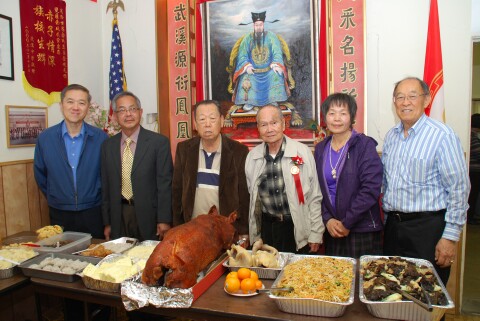
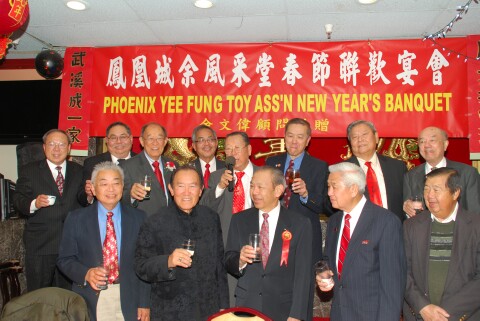
At noon at the Yee Fung Toy Family
Association Clan Hall, the typical rites of ancestral
veneration were performed, highlighted by the attendance
of Alan Yee and his wife Edith from Los Angeles on their
seventh trip to join us since 2003 and by the presence
of nonagenarian Bill Yee who came down from his
Flagstaff home for the occasion.
There is an all too widespread and
erroneous belief in the local Chinese American community
that these are rites of ancestor worship, rather than
deep respect/veneration. In fact, Yee Fung Toy is
generally honored among the Cantonese Yee clan
associations in North America, but not in Hong Kong or
other areas of China and east or Southeast Asia. In
Standard Modern Chinese, his name would be rendered as
Yu Fengcai, and he lived from 1000 to 1065 C.E. He had
become a renowned scholar-official during the Northern
Song Dynasty (960 to 1125 C.E.) and on his death, he was
posthumously honored by the reigning Emperor who decreed
his elevation to the ranks of nobility as a Duke, with
the title of Zhongxiang “Loyal Assisting.”
Were this a case of ancestor worship,
per se, the rites should be performed to honor of a
specific prime minister of the Qin state, where Duke Mu
(before his successors took the title of King, and in
due course, one descendant becomes the Qin First Emperor
Qin Shi Huangdi as his armies concluded their unifying
conquests and the establishment of imperial unity in 221
B.C.E.) citing Yao Yu for his courage, vision, and
contributions to Qin’s rising eminence declared that his
personal name henceforth would be a surname. His sons
were of course already born and named, so it is his
grandchildren who are the first Yees ever. Thus, these
traditional rites (which 2 millennia before Christ
mutatis mutandi were the rites of royal ancestor worship
by the Shang Dynasty kings) are now only rituals of
filial devotion to our forefathers as enacted to recall
their memory and to spur the emulation of a Model
Ancestor of merely a millennia ago.) These are the rites
by which Chinese culture has historically in its own
manner in fact honored the first of the Ten Commandments
having to do with human relations.
The Chinese character used in this
specific imperial enfeoffment to mean “assisting”
indicates through its etymological derivation that one
rolls up the pantlegs and the sleeves in order to engage
in the arduous, dirty, and regularly smelly challenge of
agricultural labor. In this tradition of practical,
hands-on achievement the evening banquet – again this
year a full house at Great Wall Hong Kong Cuisine in
Phoenix – saw two other “surprise” highlights. Master of
Ceremonies Jack F. Yee was able to introduce his
daughter, Arizona State Senator Kimberly Yee, herself a
pioneering first ever Chinese-American woman to be
elected first to the lower and now to the upper chamber
of the state legislature, to present a special
certificate of recognition from that chamber to
long-time clan and community leader Rudy Yee.
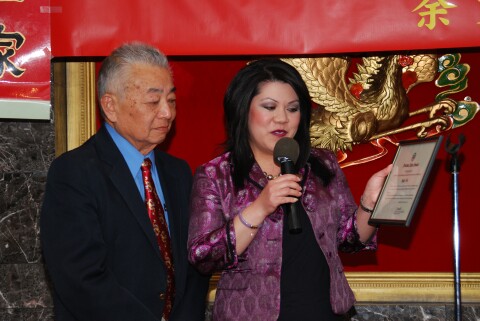
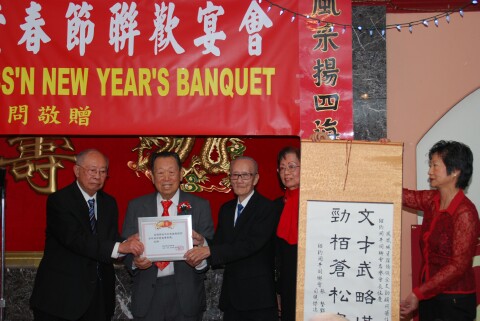
This was followed by a presentation to
John M. Yee, a grand elder among Yees nationally and
indeed internationally, of a scroll and certificate
whereby the New York Chapter of the Kaiping Natives
Association designated him as Honorary President, which
received a full page congratulatory display
advertisement in the Amwest Chinese Post newspaper.
It was certainly the case, however, that
due and dutiful appreciation for honors took second
place to the warmth and enjoyment of musical art on this
evening. First, Ms. Lude He, recently arrived from
Shanghai, performed on the gu zheng, a plucked zither of
18-23+ strings. She not only rendered well-known
traditional works, but also intrigued by showing how
Irving Berlin’s perennially popular God Bless America
could sound according to the different musical intervals
of this ancient instrument with its considerably wider
range that the likely more ancestral guqin of 7 strings.
Ms. He’s skill justifiably has won wide acknowledgement
and the opportunity to perform before three U.S.
presidents (so far).
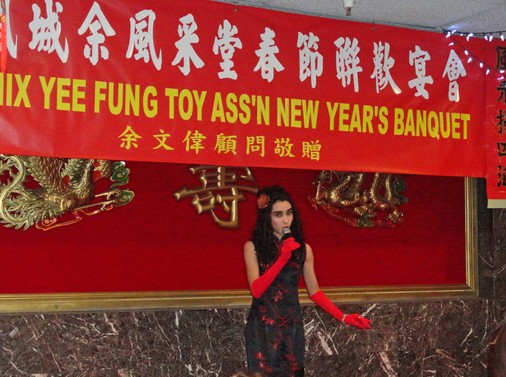
Next, but hardly second in audience
reception, was Ms. Victoria Vilead who sang to karaoke
accompaniment songs of modern popularity in both
Cantonese and Mandarin as well as English. Ms. Vilead is
not of Chinese ethnicity, once more proving the
universality of music as a bridge between cultures and
unifying peoples. Moreover, she is now a student in her
second year of study of Standard Modern Chinese at the
Phoenix Chinese School. Mr. David Cui, principal
thereof, delighted to learn of this fact unknown to him,
used his rueful admission to highlight the potential to
be gained by cultural exposure and study.
Once again, the happiness of the evening
concluded with a raffle where the generous support of
Great Wall, of Red Wok Buffet, of New Hong Kong
Restaurant, and of Super L Market provided numerous gift
certificates to lucky winners. It is likely that prize
or not, all the diners will have felt this was an
evening of winning and well-worthwhile enjoyments of
food, family, and friends.
Report by Yee
Moon-cheak,
Photos by John Tang
Phoenix, Az.
Photos by John Tang
Phoenix, Az.
斐匿余風釆堂慶祝購買產業廿四週年
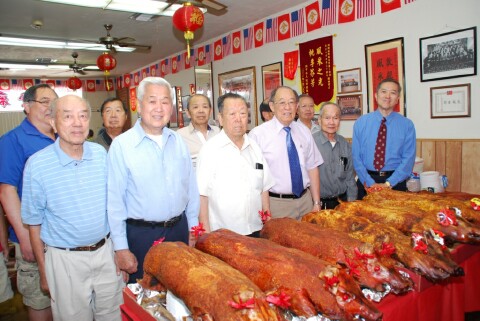
斐匿余風采堂二十四週年堂慶於四月廿七日中午在堂廳舉行祭祖儀式。
會所內充滿喜興氣氛。正中的余忠襄公畫像前陳列著六隻金豬,祭祖禮成後,
大家享用將早已準備好的美味飯菜,加上切件的金豬。
餐後分派燒肉,每人一份,皆大歡喜,大家希望明年再來歡敘。
斐匿余風采堂訊
PHOENIX YEES CELEBRATE CLAN HALL ANNIVERSARY
On April 27th, Saturday, the warmth of
Springtime in Arizona was more than matched by the good
spirits and full-house attendance (nearly 150 persons)
at the Phoenix Yee Fung-toy Family Association 24th
Anniversary of the opening of the Clan Hall. As always,
whole Cantonese style Roast Pigs were generously
provided to highlight the buffet luncheon and to provide
succulent slabs to take home; any Yee seniors over age
75 got double the distribution – something golden indeed
to look forward to in our golden years!
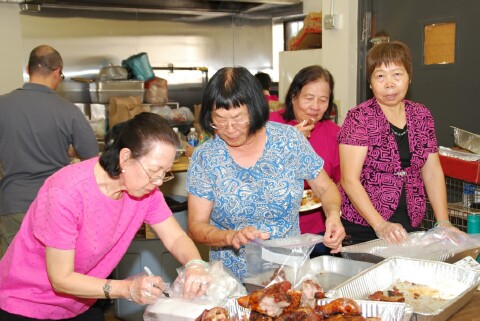
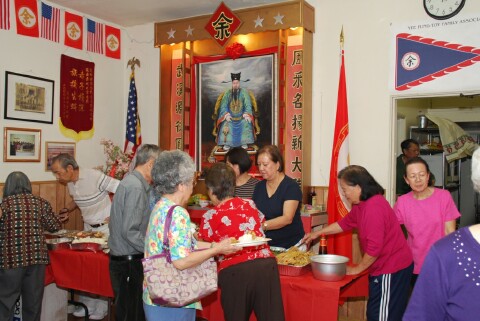
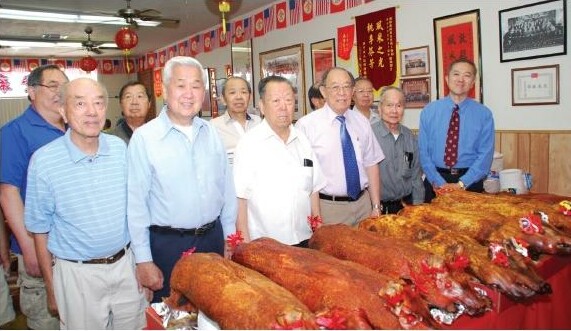
This year, the following individuals made pigs roasted by three different local restaurants available for delicious delectation:
| Dr. & Mrs. Berne Yee | ||
| Mr. & Mrs. David M. Yee |
||
| Mr. & Mrs. Carl Yee |
||
| Mr. & Mrs. Guy Lee |
||
| Mr. & Mrs. Dean K. Yee |
||
| Mr. & Mrs. Kam Yi Yee |
||
| Mrs. Jerry M. (Janet) Yee |
(Grand Elder John M. Yee had provided
the single roast pig for the informal Clan Hall luncheon
preceding the annual Yees Spring Festival Banquet last
March 9.)
Another tradition on such an occasion is the observance of the rites of ancestral veneration. As has been recently noted, there is a misinformed misconception that such rites constitute ancestor worship. This unfortunately rather widespread notion derives from several different sources – linguistic, cultural, and some religious interpretations. What is involved are two sets of three bows, the formal offering of the roast pigs, of incense, of ceremonial “ghost” money, and a libation of wine – by the entire assembly, but especially by the Clan Association officers.
At the Clear Bright Festival (Qing Ming Jie), which falls 120 days after the winter solstice, on about April 4 or 5, families will head to the nearby hillocks where the ancestral graves are situated apart from valuable arable flat land, “walk(ing on the) mountain” in order to conduct typically more involved acts of respecting one’s ancestors: to trim the overgrown vegetation, to freshen the paint on the tombstone, and then to lay out after the incense and wine a more considerable feast with the modern equivalent of the ancient “three live” whole animals as offered by Shang Dynasty kings, 3 millennia ago: an ox, a ram, and a pig – nowadays, usually a whole chicken or goose, a whole fish, and a slab or two of pork.
This is a custom quite similar to the Aztec and modern Mexican Dia de los Muertos which is the Feast of All Souls on November 2 (after the Feast of All Saints). And, it is not quite as intimate as the custom in parts of Sicily where the deceased (assuming still in reasonable condition) is brought to the family dinner table to sit and preside over the chats and reminiscences of their living descendants… It is reasonable to see all such as a natural human reflection of the divine injunction in the Fourth Commandment to honor one’s parents.
Moreover, Yee Fung-toy, or Yu Fengcai in Standard Modern Chinese, is not the ancestor of all Yees. He is only the Model that all Yees are to emulate: for after decades of service as a scholar-official in the Northern Song Dynasty (960 to 1127 C.E.), on his death in 1065 C.E., the reigning Emperor conferred upon him noble rank as the Loyal Assisting Duke. The first Yees were the grandchildren of a Chancellor of the Qin Duchy that would become the Qin Kingdom, and finally would unify Tian Xia ("[All] Heaven Under") and so confer on the new imperial realm its name – rendered as “China” – by the no-limit-to-his-ambition Qin Shi Huangdi – First Emperor of the Qin, whose tomb the terracotta army still guards against enemies coming westward from the conquered regions eastward rising in revolt, as indeed they did and ended his dynastic succession after only 15 years altogether of totalitarian sway over the longstanding feudal rivals.
And, to be sure, all Chinese officially theoretically could trace their lineage to one of the 9 sons of the nearly legendary Huang Di (here, the characters indicate not “Imperial Ruler” as in the new title created to indicate superiority over merely a Wang, or King, but rather "Yellow Ruler"). So, indeed a supposed family tree links that Chancellor grandfather to one such son; if ancestor worship were involved, all the Clan Associations would formally be able to post some idealized portrait of a single man: Huang Di, the leader of the tribe that consolidates rule in the Wei River valley, tributary to the Huang Ho (yes, Yellow River) perhaps over 4 millennia ago.
Instead, the Clan Associations arose
during the heyday of the Northern Song imperial
examination system, antecedents over a millennium old,
and solidifying the rule of the centralized and
bureaucratic empire as the older aristocratic elites
during the preceding Tang Dynasty (618 to 906 C.E.)
faded into history. Led by the polymath Fan Chung-yen,
protégé of the renown Ou-yang Hsiu, as men of often
quite humble origins came to prominence, the kinship
group by patrilineal descent began to build clan halls,
write clan histories, and establish clan schools so that
more promising pupils could climb the ladder of success
in imperial China.
The scholar-official is thus a unique
type in world history, and a shining star of ideal rule,
virtually a mini-philosopher king as envisioned by
Platon (Aristokles, son of Ariston, usually rendered
from the Latin as Plato), praised by such as Voltaire as
Europe of the Enlightenment sought to escape the rule of
parasitic nobles and doctrinaire churchmen. So ingrained
was this path of success – study hard, test well,
achieve office, gain wealth – that the emblematic and
nigh universally present in homes and in businesses of
the Three Blessings, Fu Lu Shou, which the first and the
third being obviously the good fortune of having sons,
and of gaining long life, has Lu – Wealth – represented
by a scholar-official: with cap of office, belt of
office, and scepter of office. This glory of ancient
China now ironically casts a continuing and troubling
shadow today on both sides of the Straits in terms of
practical politics and personal aggrandizement.
Report by Yu Wen-chuo
(M. Cheak Yee),
Photos by John Tang
Phoenix, Az.
Photos by John Tang
Phoenix, Az.
Senator Yee named
2013 Legislator of the Year
Congratulations!
Sen. Kimberly Yee (R-Dist. 20) received
the 2013 Legislator of the Year award from the Arizona
Association of County School Superintendents. Senator
Yee was honored for her efforts of behalf of K-12 public
education. Senator Yee chairs the Senate Committee on
Education.
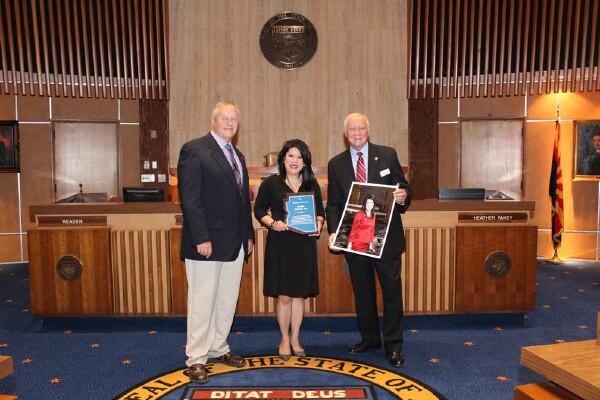
Sen. Kimberly Yee receives the award from Yavapai County Superintendent of Schools Tim Carter and Maricopa County Superintendent of Schools Don Covey.
The award states,
“To honor your dedicated efforts as a Member of the
Arizona Legislature in providing reasonable and fair
public education policy for the benefit of Arizona,
the Arizona Association of County School
Superintendents, hereby thanks you and offers our
sincere appreciation for your service.”
The award was presented to Senator Yee
on the floor of the Arizona State Senate by two members
of the Association, Maricopa County Superintendent of
Schools Don Covey and Yavapai County Superintendent of
Schools Tim Carter.
“I am truly honored to receive the 2013
Legislator of the Year award from the Arizona
Association of County School Superintendents,” Senator
Yee said. “We share a deep passion for our school
children and making education a priority at the state
and county levels. I look forward to continuing to work
closely with the association on important education
issues facing Arizona schools.”
Although the Senate is not in session
right now, Senator Yee is staying busy with her focus on
education. She is co-chairing the School Safety Program
Oversight Committee at the Legislature. Additional
school safety funding is one of the senator’s highest
priorities.
Phoenix Yees Happiest Autumn Picnic Yet
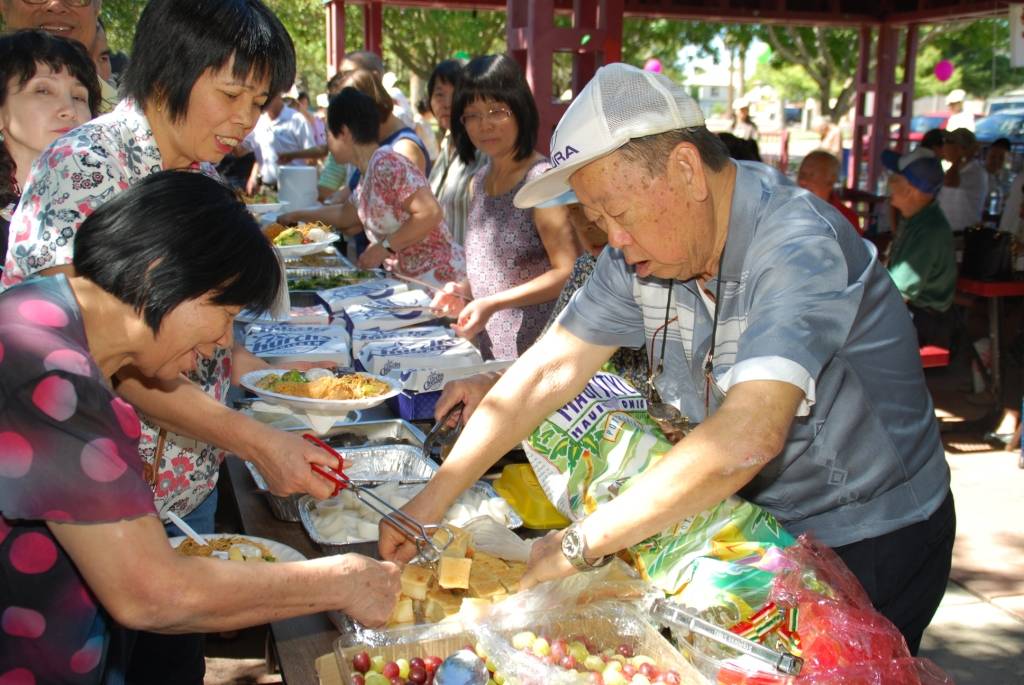
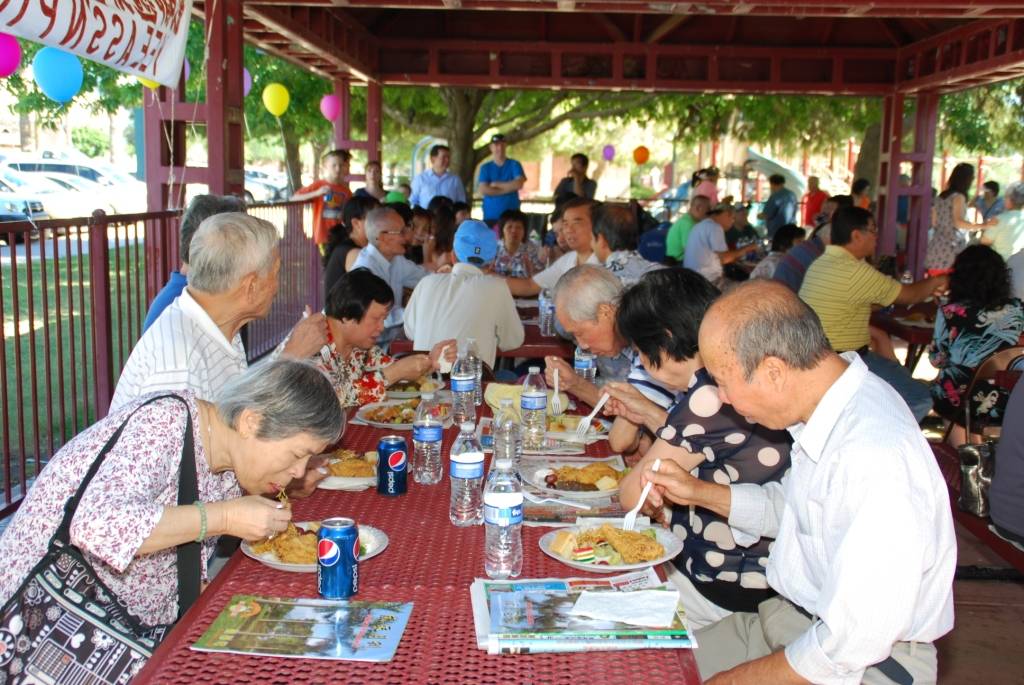
In places further north than Arizona,
the September equinox may more routinely bring the nip
of a cooler season even if “Indian summers” may
intervene. For the Yees of Phoenix, set in the Sonoran
Desert, it needs another couple of weeks before pleasant
weather for a seasonal picnic is confidently assured.
Thus, the annual outing for a shady and grassy picnic at
the City of Phoenix centrally-located (Mayor) Margaret
Hance Park will be weeks after the celestial tipping
point out of summer.
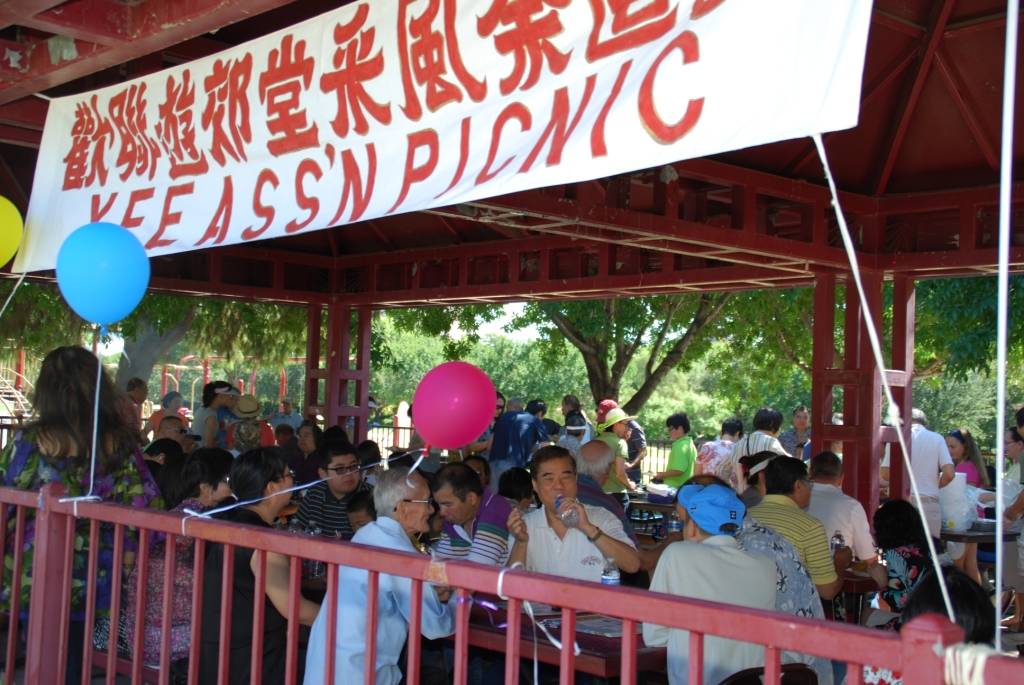
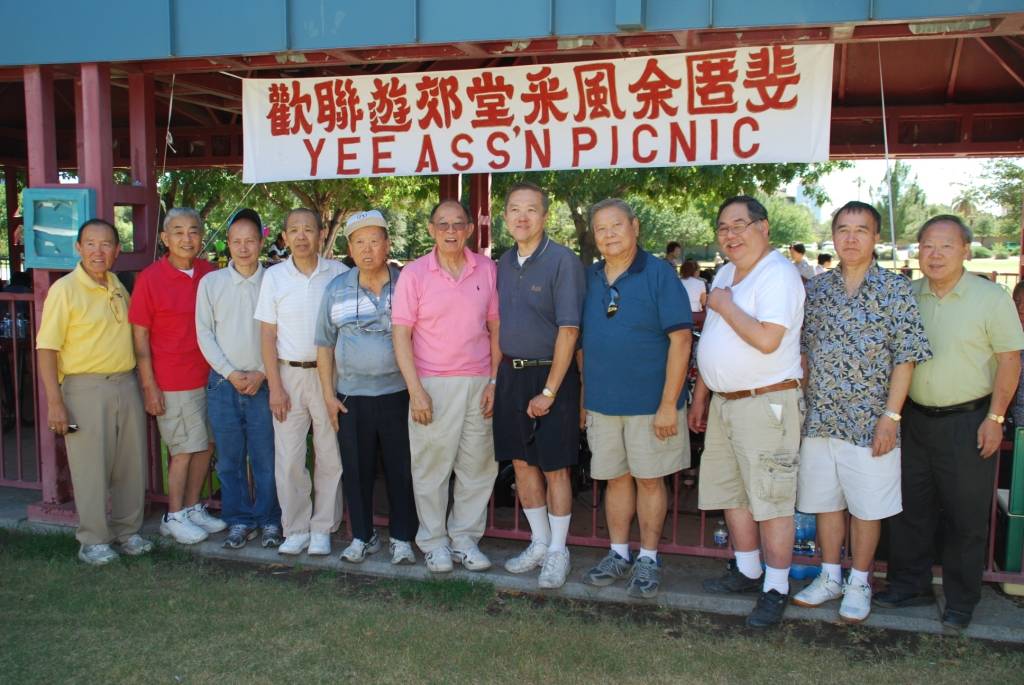
In 2013, the date was October 6th, and
the very welcome site again was the City of Phoenix
(Mayor) Margaret T. Hance Park just across a field from
the lovely landscaping, koi ponds, waterfall, and
cultural accents of the Japanese Friendship Garden. Our
own Phoenix Yee Family Association Adviser David M. Yee
has long served, as well as led, the civic organization
which supervises the Friendship Garden so he was once
again able to procure free admission tickets for the day
of our event as an added treat. Alternatively, the
Garden was a restful retreat from the hubbub and
barbeque smoke and the crowd of the Picnic into the
renown quiet of Japanese gardening style and ethos:
influenced by the popularity of Zen meditational school
of Buddhism and guided by the constraints of limited
space to intense attention to the selection,
growth/pruning, and placement of all elements, this
expansive cultural jewel in our entirely different
Sonoran desert metropolis certainly conveys to the
visitor the scent and scenery of Asia, even if this is
not quite the more florid and nigh-overgrown approach of
the typically naturalistic Chinese gardening style.
(Zen, of course, is merely the
pronunciation in Japanese of the kanji – which in turn
is merely the pronunciation they have for those two
Chinese characters, that themselves are rendered in
Chinese pronunciation as hanzi and which of course means
“Chinese character” – for the original name of this
school: Chan means meditation. As with so many aspects
of the cultures of the sprachbund [the academic term
from the scholarly field of linguistics, in German, for
a speech federation or union] of Japan, Korea, and
Vietnam, the root written language is Chinese, although
none of these peoples natively speak a language related
to Chinese, and these outlying peoples and nations
adopted and then adapted the language and key cultural
elements of China before then adapting them quite
distinctly to their own situations and preferences. Chan
has thus a continuous and divergent history both in its
original homeland of China, and then in its Korean and
Japanese variants.)
On this occasion, the crowd indeed was
larger than ever, likely over 350 during the course of a
busy morning and afternoon. The quantity of American
picnic standards supplemented by Chinese side dishes
proved barely adequate for latecomers. No doubt next
year, the adjustments will be to plan for more food, and
for attendees to arrive earlier if their Sunday
schedules permit. With many hands and happy spirits, the
event included a traditionally loud raffle of many
dozens of door prizes, and then concluded in a smoothly
conducted break-down and clean up. Thanks to the long
experience of Grand Elder John M. Yee, our picnic raffle
prizes both suffice to provide something to a majority
of the attendees (even this time), and consist of useful
items for kitchen and household – a practical touch for
a family association to be sure.
Hance Park is most centrally located in
Phoenix, with extensive parking available in lots and on
the adjacent neighborhood streets; as a rather more
modern facility (compared to the longtime earlier venue
at the City’s historic Encanto Park), it is proving to
be a popular choice, although in a few years the
Association may need to consider relocating to
accommodate the happy problem of being just a bit small
for the crowd of all ages, and many well-wishing friends
too.
Report by M. Cheak Yee,
Photos by John Tang
Phoenix, Az.
Photos by John Tang
Phoenix, Az.